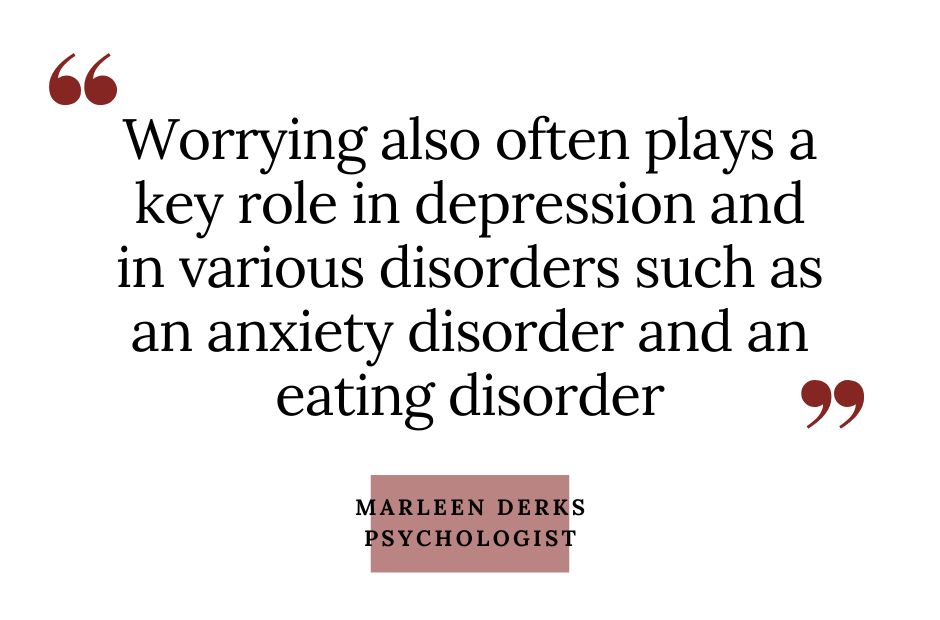When someone says, don’t worry about it, it is probably the classic example of something that is easier said than done.
War, the cost of living, the climate emergency… there seems to be no end of situations which we can worry about these days. So many people are trapped in their own thoughts worrying about the future, or indeed the past. This can lead to sleepless nights, distraction during the day and physical and mental illness.
"Worrying is continuing to think in circles," psychologist Marleen Derks told De Morgen. "The result is often that you don't come to a solution to the problem you're worrying about."
According to research quoted in the De Morgen report, people mainly worry about doomsday scenarios (40%) and things that happened in the past (30%).
"We usually worry about money, our health, children, relationships and work," Marleen Derks added. "Women worry the most and especially about relationship-oriented situations. Men often worry about task-oriented things like a deadline at work or whether they've accomplished enough to be a good husband or father."
Worrying can be accompanied by complaints such as abdominal pain, headaches, decreased appetite, insomnia and stress.
"In the treatment of these disorders, the first logical step is often to tackle worrying."
Yet worrying can be productive and when used as a form of self-protection, it can also be useful. Our brains use worrying to protect us from future setbacks, according to Ad Kerkhof, professor of clinical psychology, psychopathology and suicide prevention at the Vrije Universiteit in Amsterdam.
For example, during an anxious dental visit in the coming days, the patient is already thinking about how they can deal with it and how they will react. This slightly reduces the anxiety as you are preparing for the worst.
Potentially very damaging
However, constant worrying can be extremely damaging. "When worrying becomes compulsive, self-protection can turn into self-torment," Kerkhof told De Morgen. "People who worry up to 24 hours a day have an increased risk of suicide."
"They lose control and end up in a vortex of thoughts, feelings and images about death, their own death and suicide. Worrying can therefore eventually become life-threatening if it turns into compulsive thoughts."
"If you say to yourself: stop worrying now, it has the opposite effect," Kerkhof added. He swears by the 'worry quarter'. For fifteen minutes you give space to all the worrying thoughts that come to mind.
"Then write them down," Kerkhof explained. "Don't worry again until after lunch or dinner, for example. You learn to put off worrying."
The professor is also an advocate of positive worrying. "Worry about positive things for five minutes of the worrying quarter," Kerkhof said. "About a pleasant memory or about something you are proud of. Only after those five minutes do you continue with negative worrying. So you've had a little break from your negative thoughts."
According to Marleen Derks, in order to reduce excessive worrying, it is first important to check whether what you are worrying about is also correct. "Discuss the problem with a friend," the psychologist said. "They won't see it the way you see it, so from their perspective, it's not too bad. This can help.''
What also helps, according to Derks, is looking for distraction in the form of movement. "Go for a walk or bike ride. Exercise can help to combat restlessness and worrying. Moreover, it offers relaxation, because you exert yourself physically."
If worrying has a major impact on health and functioning, treatment is needed. There are several treatments for worrying, including cognitive behavioural therapy.
The choice to tackle worrying
Derks developed the 'Choice method', which stands for Choosing, Emotion Management, Executing, Self-Reflection and Evaluation. "The focus here is both on the thoughts and feelings, and on the behaviour,” she said. "That's how you tackle worrying quickly."
The first step, Choosing, focuses on the level of your thoughts: "Is it true what I think?". The second step is Emotion Management. "What am I feeling and why? Examine your emotions."
In the Execute step you learn in practice how to tackle problems, based on thoughts and feelings. In the Self-reflection step, thoughts, behaviour and feelings come together.
"During the last step, Evaluate, you gain insight into where your strengths lie, what your failings are and what you want to work on further."


